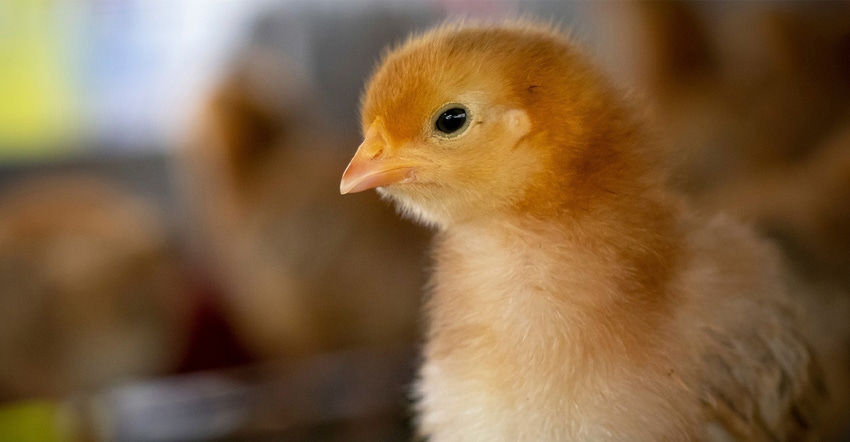
Baby chicks are popular gifts in the spring, but it is important to remember that even birds that look healthy can transmit Salmonella, said Oklahoma State University Extension specialists.
The federal Centers for Disease Control and Prevention final update on the 2020 Salmonella outbreak associated with backyard poultry indicated there were a total of 1,722 cases of Salmonella infections in people in the United States. More than 3,300 people were hospitalized with the disease in that instance. One person died from the bacterium, and that lone death occurred in Oklahoma.
“Nearly one in four cases were in children under 5 years of age,” said Dr. Barry Whitworth, OSU Extension veterinarian and food animal quality and health specialist. “Oklahoma reported 15 cases of Salmonella infections, with 66% of the sick people reporting they had contact with chicks or ducklings. Keep in mind, the CDC believes that many cases go unreported.”
Chicken, ducks and other poultry carry the Salmonella organism. Key facts to remember include:
Salmonella bacteria do not typically make birds sick.
The bacteria are in the droppings of poultry and can be found on their bodies. The bacteria can contaminate cages, coops, feed and water dishes, and the area where the birds roam.
People can be infected when handling poultry, entering poultry areas, handling equipment associated with poultry and gathering eggs, in addition to eating poultry.
Salmonella infections in humans are associated with the digestive tract. Typical clinical signs are diarrhea, vomiting, fever and abdominal cramps. If the infection goes from the intestinal tract to the blood, the disease will usually become more severe. Most people with severe infections will require hospitalization.
Parents and leaders overseeing 4-H or FFA poultry projects must ensure that children and other participants wash their hands after poultry contact. Whitworth recommended the following guidelines to reduce the chance of contracting Salmonella:
Wash hands with soap and water after having any contact with poultry or any area where poultry are located. If soap is not available, use a hand sanitizer.
Do not allow poultry to enter areas where food and drinks are prepared, served and stored.
Do not eat or drink where poultry are located.
Cook eggs thoroughly.
Clean equipment associated with poultry outdoors. Do not wash food and water dishes for animals in the kitchen sink.
“Having chickens in the backyard or exhibiting poultry at the county fair can be very rewarding experiences,” Whitworth said. “However, poultry owners should be aware of the potential for a Salmonella infection and always practice good hygiene and biosecurity.”
Dana Zook, OSU Extension area livestock specialist for northwestern Oklahoma, offered the following biosecurity checklist for small flock operators:
Use gloves when handling poultry or cleaning poultry house.
Quarantine all birds that have been to a show, exhibition or swap meet. Birds may have picked up a disease from the event and steps should be taken to keep it from infecting the rest of the flock.
Do not allow wild birds to comingle with domestic poultry. Waterfowl and small flying birds can introduce diseases into the flock.
Maintaining cleanliness is an important biosecurity measure for all livestock, but even more so for small flocks in urban areas. Properly maintaining structures and keeping things clean will prevent strong smells and flies.
Wear a mask when conditions are dusty, such as during a deep clean.
Resist the temptation to show off poultry on-site. Minimizing interaction with the birds will keep people safe from disease and birds safe from any potential health problems people may unwittingly introduce.
“Be aware that some people don’t have immunity to many of the organisms found in chickens and other livestock,” Zook said. “Good hygiene and biosecurity can go a long way in keeping people safe and preserve the excellent learning experience that comes with caring for livestock.”
Additional information about Salmonella is available online from the CDC and by contacting the Oklahoma State Department of Health Acute Disease Service.
A self-paced OSU Extension course providing an overview of issues that new poultry owners can expect to face as they select and care for their flocks is available online. The course features interactive learning activities and videos. Fact sheets detailing research-based information about best poultry management and handling practices are available online from OSU Extension and through OSU Extension county offices across the state.
Source: is OSU, which is solely responsible for the information provided and is wholly owned by the source. Informa Business Media and all its subsidiaries are not responsible for any of the content contained in this information asset.
Read more about:
SalmonellaAbout the Author(s)
You May Also Like




